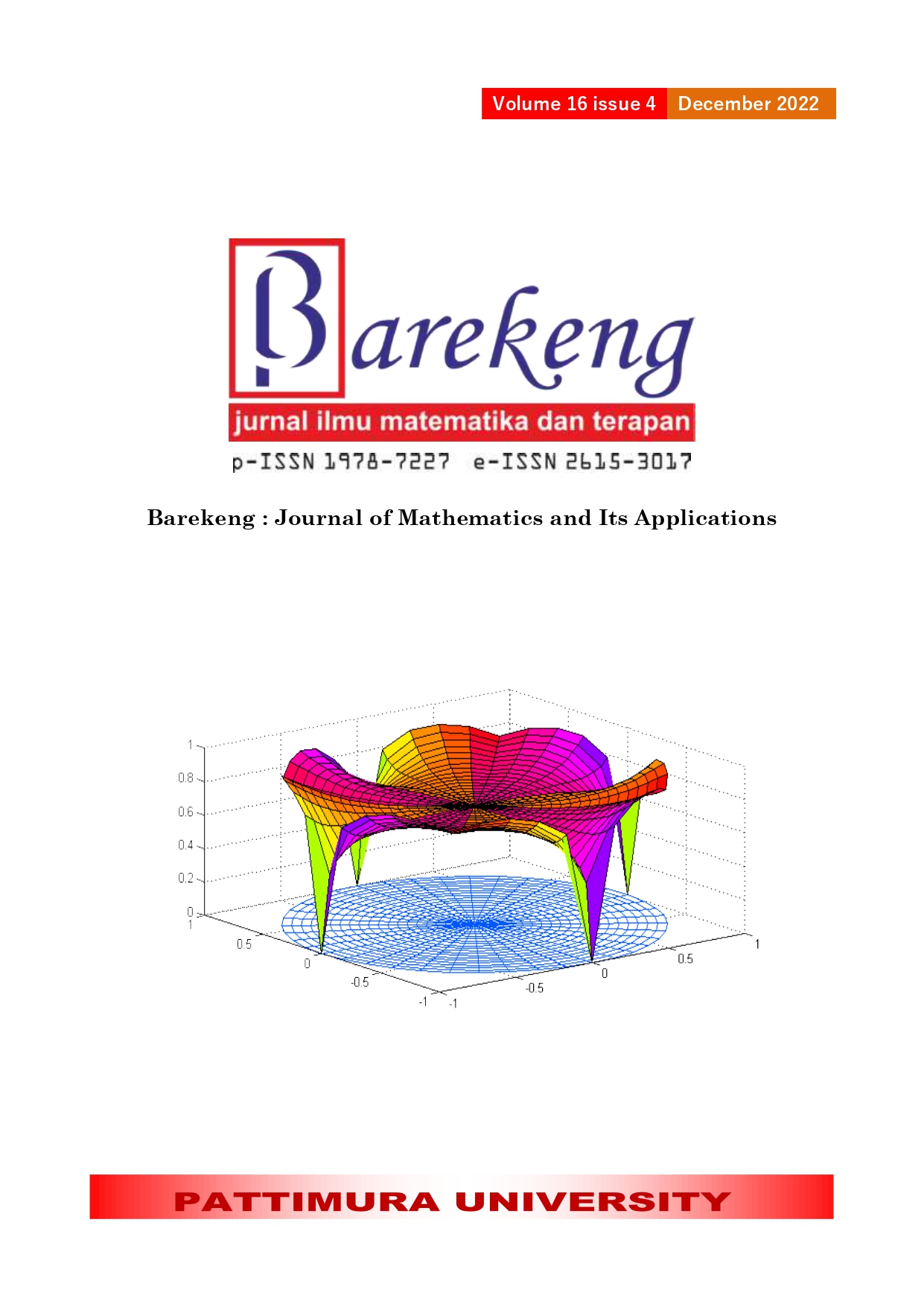LEE-CARTER MODELING FOR MORTALITY IN INDONESIA WITH A BAYESIAN APPROACH
Abstract
This study aims to model Lee-Carter mortality with a Bayesian approach, where the parameters in the model are assumed to be random variables. The data used in this study is data on mortality rates by age group from the period 1950–2015. The sourced of data was from the UN website. Age groups are categorized by age 0 years, 1-5 years, 6-10 years, 11-15 years, ..., 86-90 years. The results of this study are from Bayes estimation obtained information that the average infant mortality rate (population aged less than one year) is high, then at the age of toddlers (1-4 years) average mortality rate decreases. Furthermore, the average mortality rate for children, adolescents, young and older people has increased again. Meanwhile, the relative speed of the pattern of changes in mortality at infant age (less than one year) is high enough. At the age of toddlers (1 – 4 years), the pattern of changes in mortality has increased. Then, in the population of the next age group until the older age group, the mortality continues to decrease. The pattern of changes in mortality is lowest in the elderly population.
Downloads
References
S. H. Preston, P. Heuveline, and M. Guillot, Demography Measuring and Modeling Population Processes. United Kingdom: Blackwell Publishing, 2004.
R. D. Lee and L. R. Carter, “Modeling and Forecasting U. S. Mortality,” J. Am. Stat. Assoc., vol. 87, no. 419, p. 659, 1992, doi: 10.2307/2290201.
N. LS, “Modeling and Forecasting Norway Mortality Rates using the Lee Carter Model,” Biometrics Biostat. Int. J., vol. 6, no. 1, pp. 1–10, 2017, doi: 10.15406/bbij.2017.06.00158.
N. Ngataman, R. I. Ibrahim, and M. M. Yusuf, “Forecasting the mortality rates of Malaysian population using Lee-Carter method,” AIP Conf. Proc., vol. 1750, no. June 2016, 2016, doi: 10.1063/1.4954522.
L. Safitri, S. Mardiyati, and H. Rahim, “Estimation of mortality rate in Indonesia with Lee-Carter model,” AIP Conf. Proc., vol. 2023, no. October 2018, 2018, doi: 10.1063/1.5064207.
A. H. A. Zili, S. Mardiyati, and D. Lestari, “Forecasting Indonesian Mortality Rates Using the Lee-Carter Model and ARIMA Method,” vol. 02021, 2018, doi: 10.1063/1.5064209.
M. C. Koissi, “Fitting and Forecasting Mortality Rates for Nordic Countries Using the Lee-Carter method,” pp. 1–21.
H. Lundstr and J. Qvist, “Mortality Forecasting and Trend Shifts : an Application of the Lee – Carter Model to Swedish Mortality Data £,” pp. 37–50, 2004.
J. C. Hernandez and A. Sikov, “Lee-Carter method for forecasting mortality for Peruvian Population,” Univ. Nac. Trujillo, vol. 8(1), pp. 52–65, 2021, doi: dx.doi.org/10.17268/sel.mat.2021.01.05.
A. Yadav, S. Yadav, and R. Kesarwani, “Decelerating Mortality Rates in Older Ages and its Prospects through Lee-Carter Approach,” PLoS One, vol. 7, no. 12, 2012, doi: 10.1371/journal.pone.0050941.
S. Baran, M. Isp, and G. Pap, “Forecasting Hungarian Mortality Rates Using The Lee – Carter Method,” vol. 57, no. 1, pp. 21–34, 2007, doi: 10.1556/AOecon.57.2007.1.3.
W. Aberathna, L. Alles, W. N. Wickremasinghe, and I. Hewapathirana, “Modeling and Forecasting Mortality in Sri Lanka,” Sri Lankan J. Appl. Stat., vol. 15–3, pp. 141–170, 2014, doi: 10.4038/sljstats.v15i3.7794.
W. Dhandevi, H. M. Kang, and R. R. Ponnusamy, “Lee-Carter Mortality Forecasting : Application to Mauritian Population,” no. 5, pp. 169–175, 2019.
C. Pedroza, “A Bayesian forecasting model: Predicting U.S. male mortality,” Biostatistics, vol. 7, no. 4, pp. 530–550, 2006, doi: 10.1093/biostatistics/kxj024.
C. da Rocha Neves and H. S. Migon, “Bayesian graduation of mortality rates: An application to reserve evaluation,” Insur. Math. Econ., vol. 40, no. 3, pp. 424–434, 2007, doi: 10.1016/j.insmatheco.2006.06.005.
C. Neves, C. Fernandes, and H. Hoeltgebaum, “Five different distributions for the Lee–Carter model of mortality forecasting: A comparison using GAS models,” Insur. Math. Econ., vol. 75, pp. 48–57, 2017, doi: 10.1016/j.insmatheco.2017.04.004.
Copyright (c) 2022 Muhammad Fajar, Eko Fajariyanto

This work is licensed under a Creative Commons Attribution-ShareAlike 4.0 International License.
Authors who publish with this Journal agree to the following terms:
- Author retain copyright and grant the journal right of first publication with the work simultaneously licensed under a creative commons attribution license that allow others to share the work within an acknowledgement of the work’s authorship and initial publication of this journal.
- Authors are able to enter into separate, additional contractual arrangement for the non-exclusive distribution of the journal’s published version of the work (e.g. acknowledgement of its initial publication in this journal).
- Authors are permitted and encouraged to post their work online (e.g. in institutional repositories or on their websites) prior to and during the submission process, as it can lead to productive exchanges, as well as earlier and greater citation of published works.






1.gif)



